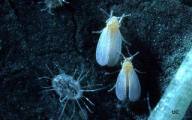Categories
Calendars
Guides
Reviews
Archive
Gallery
Articles
Ask Our Gardening Expert
Control Of Whitefly
Trialeurodes vaporariorum - when young, they appear as
small (1½mm long), scaly creatures on the underside of leaves. These scales
protect them from many insecticides. The more adult whitefly look
like tiny white moths, and they will make short circular flights
when disturbed. They are transparent to opaque and vary in
colour from creamy white through to brown.
Whitefly attacks both outdoor and greenhouse crops
but they are definitely most damaging in the greenhouse.
They are typified by small "clouds" of insects appearing
when plants are touched. They leave a sticky goo on the
leaves which turns black as it is infected with sooty
mould.
If the whitefly are attacking an outside plant
then it is unlikely to be serious. Keep the plant healthy and it
should shrug off the attack by itself. I you want to treat an
outside plant then spray with soapy water as described below. It
is also effective to use systemic pesticides (see below). If the whitefly are attacking plants in a
greenhouse then it can be serious if left to run its own course.
The best course of action is to act in advance each season.
Expect the whitefly attack from April onwards and act before it
becomes severe. The steps for this are described below as well
as how to control whitefly when the attack is more severe. Many whitefly are now resistant to pesticides so
the best course of action is biological control combined with
fly-catching sheets. The first stage in the life of whitefly is
as nymphs which attach themselves to the underside of leaves.
Theses nymphs can be biologically controlled by parasitic wasps.
The second stage of the whitefly life is when the nymphs mature
and emerge as flying whitefly. Any that get to this stage can be
controlled by fly-catching sheets. In late March or early April order online the
parasitic wasp (encarsia formosa). If you Google the Latin name
(encarsia formosa),
several suppliers will appear. Our recommended supplier of this
parasitic wasp can be found by clicking here. The wasps will eat the whitefly nymphs. The wasps work best when they are let loose
before the whitefly population is moderate. Once they have been
introduced, don't spray the tomatoes with pesticides because
that will kill the wasps. In mid-April, buy some fly-catching sheets and
hang them near your greenhouse plants. Any nymphs which are
missed by the parasitic wasps above will turn into whitefly.
Most of these should be caught by the fly-catching sheets. Many of the chemicals for killing whitefly,
including the most effective ones, are systemic. They work
because the plant absorbs the chemicals and when the whitefly
feed on the leaves, they are poisoned by those chemicals. I'm
not really sure that I would want to eat fruit / produce from a
plant which has absorbed chemicals that kill whitefly! The
biological and fly-catching sheets seem far safer.

How to Treat Whitefly
Whitefly Greenhouse Control - Act in Advance
Whitefly Greenhouse Control - Biological
Whitefly Greenhouse Control - Fly-Catching
Sheets
Whitefly Greenhouse Control - Chemical